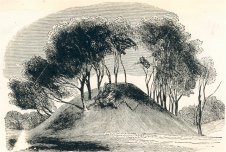
Church History
The Lands of Donnycarney
The ancient and historic Lands of Donnycarney originally stretched from the sea front at Fairview to the Donnycarney River (Sculogues Bridge – the red bridge beyond Collins Avenue). It was bordered on the north by the town lands of Puckstown and Artane South and to the west by Clonturk. These lands are now divided by the Malahide Road (the ancient Slighe Cualann) and Collins Avenue (formerly Puckstown Lane), an ancient right of way to the North / Swords Road
Tumulus
The oldest evidence of habitation in the area is to be found in the ground of Mount Temple near the railway line, where a cone shaped mound or tumulus exists. This burial mound is one of three in the general area, which testify to the presence here in the early Bronze Age of an ancient tribe that lived in the area. One theory suggests, that they were erected by the followers of Partholan, who perished of a plague and were buried around the plains of Dublin.
The earliest recorded name for Donnycarney was Duncarnac, found in the Register of All Hallows (1172), which suggests a pre-Christian settlement in the area with fortifications protecting the Slí Cualann, one of the ancient roadways from Tara.


The Name Donnycarney
Donnycarney or more precisely Domnach Cearnach, the name in Irish, is a derivative from several sources with attending variations and interpretations. Liam S. Gogan, keeper of the Art and Industrial division of the National Museum and one of the leading Celtic scholars in the early 1930’s, gave one interesting interpretation of the name. He was of the opinion that a shrine to the Gaulish horned god Cernunnos (an ancient Celtic deity) was located in Donnycarney. The Gaileanga, who were mercenaries from Gaul and used by the kings of Tara, settled in the north Dublin area and the Coolock Barony and also in various other areas in Ireland before the coming of St. Patrick. The discovery of archaeological objects on the north Dublin island of Lambay in 1927, including Roman type brooches and others with Germanic elements, may indicate occupation at some stage.
It is also recorded that the Gaileanga once occupied the land around Glasnevin, where St. Mobhi built his monastery. Mr. Gogan wrote – ” they (the Gaileanga) were probably recruited in Boulogne Sur Mer and brought with them their native Gaulish god Cernunnos ——-. His shrine was at the residential area of Donnycarney and when Christianity was brought to the people, a dominicum or church was built there, whence its name in Irish Domnach Cearnach. This spot doubtless marks their assembly ground and the residence of their king”. The name recorded in the 12th century for the area was “Duncarnac” and the Irish for Dun is a fort, which would indicate an earlier fortification occupied by a group like the Gaileanga, protecting the Slí Cualann. The Gaileanga were a people of considerable power and were famous as warriors and renowned for their prowess of spear vaulting over walls during attacks on native forts.
